Odilon Redon
| Odilon Redon | |
|---|---|
 Self-Portrait, 1880, Musée d'Orsay | |
| Born |
Bertrand-Jean Redon 20 April 1840 Bordeaux, France |
| Died |
6 July 1916 (aged 76) Paris, France |
| Education | Átelier of Jean-Léon Gérôme |
| Known for | Painting, printmaking, drawing |
| Movement | Post-impressionism, symbolism |

Odilon Redon (born Bertrand-Jean Redon; French: [ʁədɔ̃]; April 20, 1840 – July 6, 1916) was a French symbolist painter, printmaker, draughtsman and pastellist.
Biography
Odilon Redon was born in Bordeaux, Aquitaine, to a prosperous family. The young Bertrand-Jean Redon acquired the nickname "Odilon" from his mother, Odile.[2] Redon started drawing as a child; and, at the age of ten, he was awarded a drawing prize at school. He began the formal study of drawing at fifteen; but, at his father's insistence, he changed to architecture. Failure to pass the entrance exams at Paris’ École des Beaux-Arts ended any plans for a career as an architect, although he briefly studied painting there under Jean-Léon Gérôme in 1864. (His younger brother Gaston Redon would become a noted architect.)
Back in his native Bordeaux, he took up sculpting, and Rodolphe Bresdin instructed him in etching and lithography. His artistic career was interrupted in 1870 when he joined the army to serve in the Franco-Prussian War.
At the end of the war, he moved to Paris and resumed working almost exclusively in charcoal and lithography. He called his visionary works, conceived in shades of black, his noirs. It was not until 1878 that his work gained any recognition with Guardian Spirit of the Waters; he published his first album of lithographs, titled Dans le Rêve, in 1879. Still, Redon remained relatively unknown until the appearance in 1884 of a cult novel by Joris-Karl Huysmans titled À rebours (Against Nature). The story featured a decadent aristocrat who collected Redon's drawings.
In the 1890s pastel and oils became his favored media; he produced no more noirs after 1900. In 1899, he exhibited with the Nabis at Durand-Ruel's.
Redon had a keen interest in Hindu and Buddhist religion and culture. The figure of the Buddha increasingly showed in his work. Influences of Japonism blended into his art, such as the painting The Death of the Buddha around 1899, The Buddha in 1906, Jacob and the Angel in 1905, and Vase with Japanese warrior in 1905, amongst many others.[3][4]
Baron Robert de Domecy (1867–1946) commissioned the artist in 1899 to create 17 decorative panels for the dining room of the Château de Domecy-sur-le-Vault near Sermizelles in Burgundy. Redon had created large decorative works for private residences in the past, but his compositions for the château de Domecy in 1900–1901 were his most radical compositions to that point and mark the transition from ornamental to abstract painting. The landscape details do not show a specific place or space. Only details of trees, twigs with leaves, and budding flowers in an endless horizon can be seen. The colours used are mostly yellow, grey, brown and light blue. The influence of the Japanese painting style found on folding screens byōbu is discernible in his choice of colours and the rectangular proportions of most of the up to 2.5 metres high panels. Fifteen of them are located today in the Musée d'Orsay, acquisitioned in 1988.[5]
Domecy also commissioned Redon to paint portraits of his wife and their daughter Jeanne, two of which are in the collections of the Musée d'Orsay and the Getty Museum in California.[6][7] Most of the paintings remained in the Domecy family collection until the 1960s.[8]
In 1903 Redon was awarded the Legion of Honor.[9] His popularity increased when a catalogue of etchings and lithographs was published by André Mellerio in 1913; that same year, he was given the largest single representation at the New York Armory Show, in Utica, New York.
Redon died on July 6, 1916. In 1923 Mellerio published Odilon Redon: Peintre Dessinateur et Graveur. An archive of Mellerio's papers is held by the Ryerson & Burnham Libraries at the Art Institute of Chicago.
In 2005 the Museum of Modern Art launched an exhibition entitled "Beyond The Visible", a comprehensive overview of Redon's work showcasing more than 100 paintings, drawings, prints and books from The Ian Woodner Family Collection. The exhibition ran from October 30, 2005 to January 23, 2006.[10]
The Fondation Beyeler in Basel, Switzerland is showing a retrospective from February to May 2014.[11]
Analysis of his work
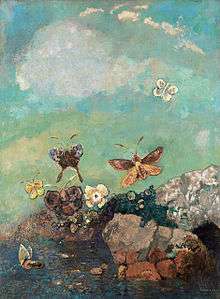
During his early years as an artist, Redon's works were described as "a synthesis of nightmares and dreams", as they contained dark, fantastical figures from the artist's own imagination.[12] His work represents an exploration of his internal feelings and psyche. He himself wanted to place "the logic of the visible at the service of the invisible".[13] A telling source of Redon's inspiration and the forces behind his works can be found in his journal A Soi-même (To Myself). His process was explained best by himself when he said:
- "I have often, as an exercise and as a sustenance, painted before an object down to the smallest accidents of its visual appearance; but the day left me sad and with an unsatiated thirst. The next day I let the other source run, that of imagination, through the recollection of the forms and I was then reassured and appeased."
The mystery and the evocation of Redon's drawings are described by Huysmans in the following passage:
- "Those were the pictures bearing the signature: Odilon Redon. They held, between their gold-edged frames of unpolished pearwood, undreamed-of images: a Merovingian-type head, resting upon a cup; a bearded man, reminiscent both of a Buddhist priest and a public orator, touching an enormous cannon-ball with his finger; a spider with a human face lodged in the centre of its body. Then there were charcoal sketches which delved even deeper into the terrors of fever-ridden dreams. Here, on an enormous die, a melancholy eyelid winked; over there stretched dry and arid landscapes, calcinated plains, heaving and quaking ground, where volcanos erupted into rebellious clouds, under foul and murky skies; sometimes the subjects seemed to have been taken from the nightmarish dreams of science, and hark back to prehistoric times; monstrous flora bloomed on the rocks; everywhere, in among the erratic blocks and glacial mud, were figures whose simian appearance—heavy jawbone, protruding brows, receding forehead, and flattened skull top—recalled the ancestral head, the head of the first Quaternary Period, the head of man when he was still fructivorous and without speech, the contemporary of the mammoth, of the rhinoceros with septate nostrils, and of the giant bear. These drawings defied classification; unheeding, for the most part, of the limitations of painting, they ushered in a very special type of the fantastic, one born of sickness and delirium."[14]
The art historian Michael Gibson says that Redon began to want his works, even the ones darker in color and subject matter, to portray “the triumph of light over darkness.” [15]
Redon described his work as ambiguous and undefinable:
- "My drawings inspire, and are not to be defined. They place us, as does music, in the ambiguous realm of the undetermined."[16]
Gallery
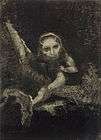 Caliban, 1881 (Musée d'Orsay)
Caliban, 1881 (Musée d'Orsay) "Guardian Spirit of the Waters", 1878
"Guardian Spirit of the Waters", 1878 The Trees, c. 1890s (Museum of Fine Arts, Houston)
The Trees, c. 1890s (Museum of Fine Arts, Houston)- Lady of the Flowers, c. 1890–95 (Honolulu Museum of Art)
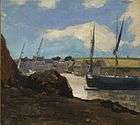 The Port of Morgat, 1882, Dallas Museum of Art
The Port of Morgat, 1882, Dallas Museum of Art- The Cyclops, 1898 (Kröller-Müller Museum)
 Ophelia, 1900–1905 (Dian Woodner Collection)
Ophelia, 1900–1905 (Dian Woodner Collection)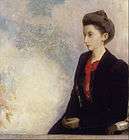 Baroness Robert de Domecy, 1900 (Musée d'Orsay)
Baroness Robert de Domecy, 1900 (Musée d'Orsay) Vase of Flowers, ca. 1900-10, (Princeton University Art Museum)
Vase of Flowers, ca. 1900-10, (Princeton University Art Museum) Flower Clouds, 1903 (The Art Institute of Chicago)
Flower Clouds, 1903 (The Art Institute of Chicago) The Buddha, 1904 (Musée d'Orsay)
The Buddha, 1904 (Musée d'Orsay) Initiation to Study: Two Young Ladies (vers 1905) Dallas Museum of Art, oil on canvas 93 x 65 cm
Initiation to Study: Two Young Ladies (vers 1905) Dallas Museum of Art, oil on canvas 93 x 65 cm Apparition, 1905–10, (Princeton University Art Museum)
Apparition, 1905–10, (Princeton University Art Museum) Flowers, 1909
Flowers, 1909 Chariot of Apollo, c. 1910 (Musée d'Orsay)
Chariot of Apollo, c. 1910 (Musée d'Orsay)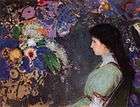 Portrait of Violette Heymann, 1910 (Cleveland Museum of Art)
Portrait of Violette Heymann, 1910 (Cleveland Museum of Art)- Saint Sebastian, 1910–1912, (National Gallery of Art)
 Coquille, 1912 (Musée d'Orsay)
Coquille, 1912 (Musée d'Orsay)- Pandora, c. 1914 (Metropolitan Museum of Art)
 Evocation, undated, private collection
Evocation, undated, private collection
References
- ↑ "Musée d'Orsay: non_traduit". Musee-orsay.fr. 1987-10-14. Retrieved 2015-03-09.
- ↑ "Online Essay on Odilon Redon". Chez.com. Retrieved 10 October 2014.
- ↑ "Odilon Redon (1840-1916) | Vase au guerrier japonais | IMPRESSIONIST & MODERN ART Auction | 20th Century, Drawings & Watercolors | Christie's". Christies.com. 2010-02-02. Retrieved 2015-03-09.
- ↑ "Odilon Redon | Press Images - Fondation Beyeler". Pressimages.fondationbeyeler.ch. Retrieved 2015-03-09.
- ↑ "Musee d'Orsay : Homepage". Musee-orsay.fr. Retrieved 2015-03-09.
- ↑ "Musée d'Orsay: Odilon Redon Baroness Robert de Domecy". 4 February 2009. Retrieved 10 October 2014.
- ↑ "Baronne de Domecy (Getty Museum)". Getty.edu. Retrieved 2015-03-09.
- ↑ "Sotheby's Impressionist & Modern Art Evening Sale" (PDF). Sothebys.com. Retrieved 2015-03-09.
- ↑ Redon and Werner (1969), p. ix.
- ↑ Danielle O'Steen (November 2005). "Dark Dreamer". ART + AUCTION. Retrieved 2008-05-20.
- ↑ "Introduction | Fondation Beyeler". Fondationbeyeler.ch. Retrieved 2015-03-09.
- ↑ Redon, Odilon, and Raphaël Bouvier (2014). Odilon Redon. p. 2.
- ↑ Redon, Odilon (1988). Odilon Redon: the Woodner Collection. Washington, D.C.: Phillips Collection. unpaginated. OCLC 20763694.
- ↑ Huysmans, Joris-Karl (1998). Against Nature. Translated by Margaret Mauldon. Oxford University Press. pp. 52–53. ISBN 0-14-044086-0.
- ↑ Gibson, Michael, and Odilon Redon (2011). Odilon Redon, 1840-1916: The Prince of Dreams. Los Angeles, Calif: Taschen America. p. 97. ISBN 9783836530033.
- ↑ Goldwater, Robert; Treves, Marco (1945). Artists on Art. Pantheon. ISBN 0-394-70900-4.
Bibliography
- Russell T. Clement, Four French Symbolists: A Sourcebook on Pierre Puvis de Chavannes, Gustave Moreau, Odilon Redon, and Maurice Denis, Greenwood Press, 1996, ISBN 0-313-29752-5 & ISBN 978-0-313-29752-6
- Jodi Hauptman and Marina Van Zuylen, Beyond the Visible: The Art of Odilon Redon, 2005, ISBN 0-87070-702-7 & ISBN 978-0-87070-702-5
- Andre Mellerio, Odilon Redon, 1968, ASIN B0007DNIKO
- Odilon Redon and Alfred Werner, The Graphic Works of Odilon Redon, Dover, 1969, ISBN 0-486-21996-8
- Odilon Redon and Alfred Werner, The Graphic Works of Odilon Redon, (Dover Pictorial Archive), 2005, ISBN 0-486-44659-X & ISBN 978-0-486-44659-2
- Margret Stuffmann, Odilon Redon: As in a Dream, 2007, ISBN 3-7757-1894-X & ISBN 978-3-7757-1894-3
External links
| Wikimedia Commons has media related to Odilon Redon. |
- Works by or about Odilon Redon at Internet Archive
- odilonredon.net – Online biography and pictures of Odilon Redon
- Artcyclopedia – Links to Redon's works
- The Athenaeum – Extensive list and images of Redon's works
- Museum Syndicate – Odilon Redon Gallery at Museum Syndicate
- Web Museum – Biography and images of Redon's works
- Odilon Redon at the Museum of Modern Art
- MoMA Exhibition - "Beyond the Visible – The Art of Odilon Redon" - MoMA exhibition (October 2005 – January 2006)
- www.odilon-redon.org – Site with 322 images by Odilon Redon